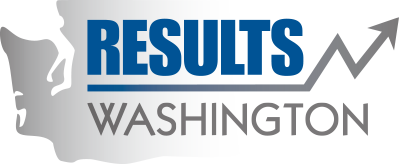WSDOT
Results Washington case study: Transportation records disclosure
Cutting public records
turnaround time
in half
Summary: The public disclosure team at Washington State Department of Transportation's headquarters cut the average time to fulfill a records request by 54 percent.
“We wanted to be faster, better, and more customer friendly”
Ashley Holmberg
The Washington State Department of Transportation’s responsibility for statewide transportation systems makes it’s work extremely visible to the public.
The nature of that work can prompt complex public disclosure requests. That complexity has increased with changes in law about exemptions. The volume of requests has also increased from 900 in 2006 to 3,300 last year.
“Basically, the public disclosure team at our headquarters was really struggling to keep up with the workload,” said Jean Denslow, who runs WSDOT’s Lean Process Improvement Office. The unit was borrowing staff from other parts of the agency to try to keep up.”
“There was lots of turnover and a huge increase in requests over the years - and there wasn’t money for more staff,” said Ashley Holmberg, a public disclosure coordinator. “So we had to do something. We wanted to be faster, better and more customer-friendly.”
“There was lots of turnover,
a huge increase in
requests over the years,
and there wasn’t money for more staff.
So we had to do something.”
Ashley Holmberg
.
Improvements: Working with Denslow, the team gathered to map out the process and find better ways to work.
“We kind of broke it down: Where were the stopping points?” Holmberg said. “We’d been going to a lot of different offices, double-checking things, and some processes were bogging us down.
Among the problems that surfaced: It was taking too long to collect records that were spread throughout the agency. Many staff weren’t clear on what was needed or how to respond. They didn’t feel empowered to ask requestors to consider clarifying a request
As a result, a significant amount of time was spent on searches that produced far more records than the requester really wanted. The amount of documents could be overwhelming for both the request requester and the agency.
Working together, the team members streamlined the process. They figured out ways to break large requests into smaller batches. Staffers now routinely ask for clarifying information from requesters, so requesters get the records they need faster. This also helps avoid the need for follow-up requests. It has also built trust with requesters.
In addition, the public disclosure request team set up a visual display to track request status and see where the delays were.
Outcome: As a result of the improvements, the unit’s average time to satisfy a records request went from 24 business days to 11, a 54% reduction.
“At huddles, we would talk about all the feedback we got,” Holmberg said. “A lot of it was really positive, with customers impressed at getting their records quickly.”
Feedback
“Far above my expectations... I liked the minimal wait time, made my day.”
- from a requester for a hydraulic drainage report
“Very quick and accurate, thanks”
- from a requester for ferry schematics
“Extremely rapid response times. Very polite staff.”
- from a requester for vehicle records
“Your response time was far quicker than I had expected. I can not think of anything that you could do better.”
- from a requester for transponder records

